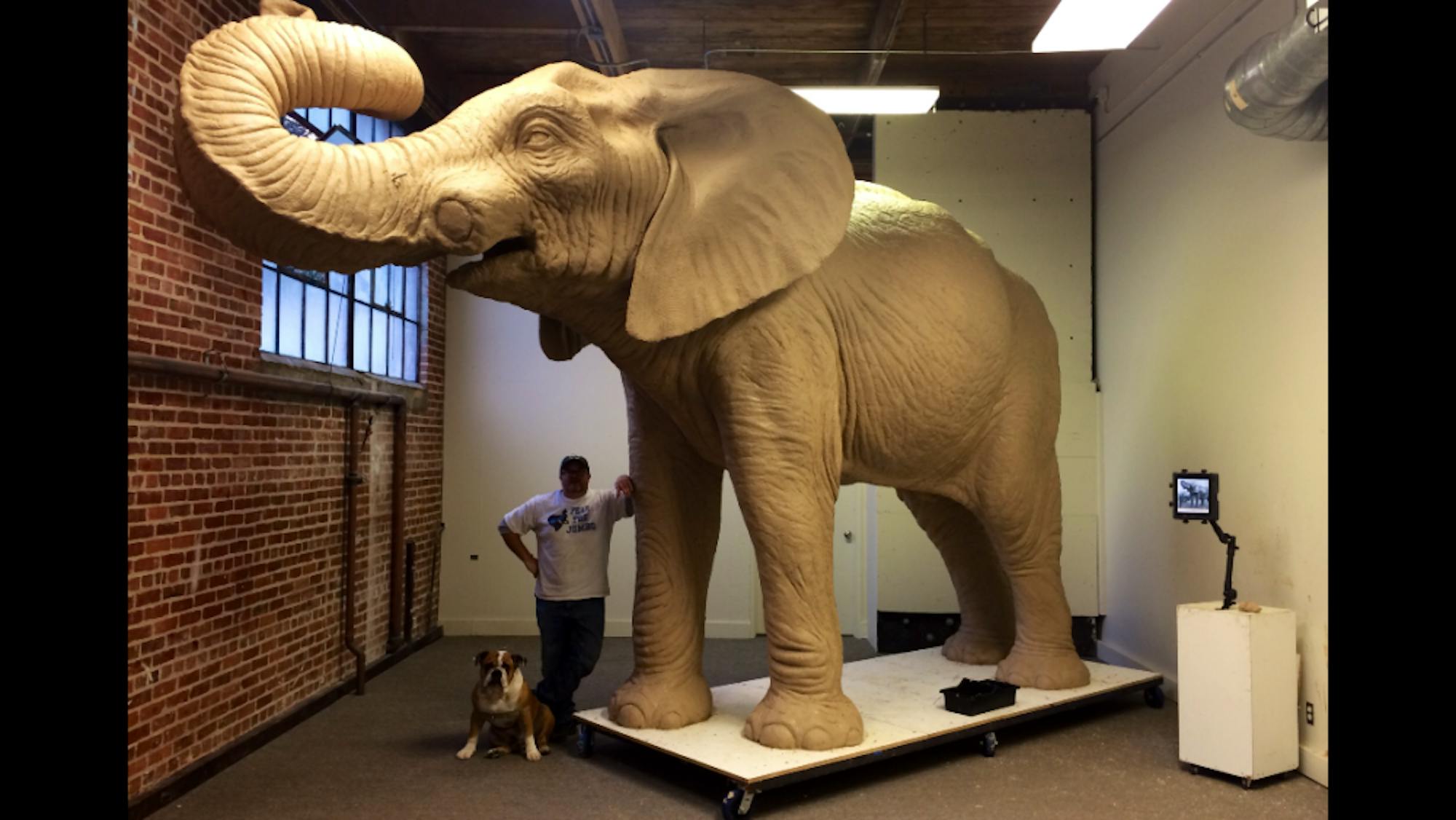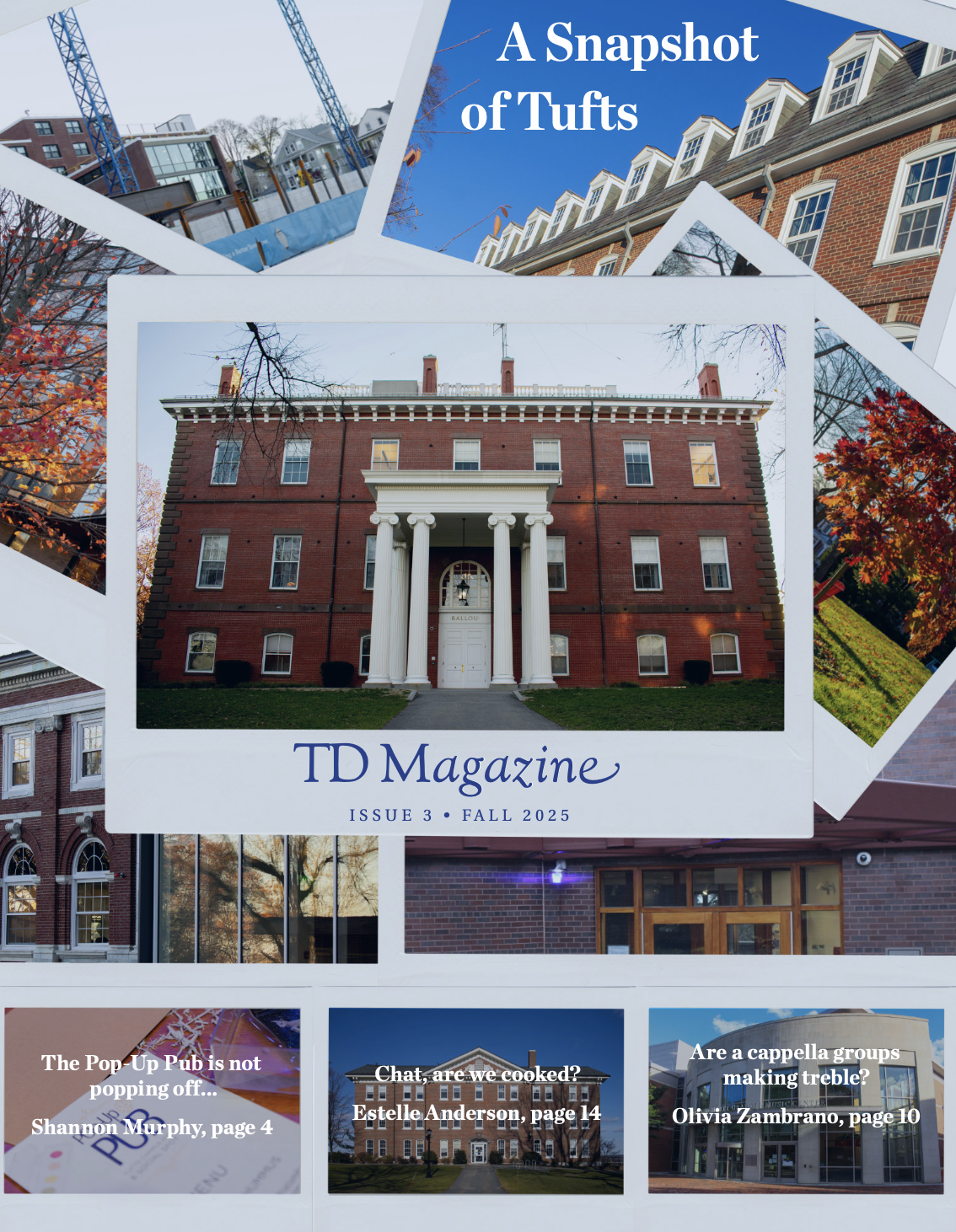Jumbo is finally on his way. The new bronze statue of Tufts' unique mascot, a 2012 donation by Tufts alumnus Richard Reynolds (LA ’67), was supposed to join the Tufts community last fall. After a long wait and extensive preparations by sculptor Steven Whyte, Jumbo is scheduled to arrive this spring.
Whyte, who is based out of Carmel, Calif., said that his work is near completion.
“I think the bronze will be completed in about 10 days,” Whyte said. “We have to patina it and wax it, and we will get it all ready. He will be finished in about two weeks, and then we will just arrange his trip after that.”
According to California local newspaper, The Carmel Pine Cone, "if all goes according to plan ... [the] sculpture of what was once the world’s most famous elephant will be unveiled April 17."
Paid for by a generous donation from Reynolds, former vice president of operations at Tufts, the new Jumbo statue was originally planned to arrive on campus on Oct. 19 in time for 2014 Tufts Parents' Weekend. The statue's delay has left many frustrated, including President Anthony Monaco.
"I stopped asking. I walk by it everyday hoping it will appear," Monaco said regarding a timeline for the statue's arrival.
Celebrating the 125th anniversary of Jumbo being instated as Tufts’ mascot, the new statue's unveiling on campus was also meant to coincide with Art and Art History Professor Andrew McClellan’s exhibit and book about Tufts' mascot, entitled Jumbo: Marvel, Myth and Mascot (2014), which focuses on the noteworthy aspects of Jumbo’s life and the mission behind building a new statue.
“[The new statue is] to celebrate Tufts mascot, the most distinctive mascot in the country," McClellan said. “Unlike the generic bobcats and cavaliers that constitute most college mascots, we have in Jumbo the most famous animal that has ever lived.”
According to McClellan, a committee was created to find a sculptor and organize the logistics of commissioning a new Jumbo statue.
“The committee was called the Ad Hoc Jumbo Statue Committee, made up of faculty, staff, students, along with Richard Reynolds, the donor,” McClellan told the Daily in an email. “We solicited proposals from three artists we found following a national search. The committee made the final selection.”
After attending the prestigious Sir Henry Dalton School of Sculpture in Britain as its youngest student, Whyte trained in the traditional techniques of figurative bronze sculpture, according to the studio’s website.He has completed several large sculptures for both public and private commissions.
This fall, he finished the largest statue at any collegiate stadium for Texas A&M, called the War Hymn Memorial. The statue depicts 12 Texas A&M students linking shoulders and feet and weighs 20,000 pounds. According to Whyte, the Texas A&M piece is about four times the size of the Jumbo statue.
“In terms of a single figure, I’ve done a couple of 12-foot pieces, but they are not the same mass as a big elephant," he said. "In terms of a single piece or figure, this is definitely the biggest.”
According to the article in the Carmel Pine Cone, Whyte began the project in late 2013 by developing potential models of the new statue to show to Reynolds and the committee. According to Whyte, building examples of potential renditions of the new statue was the first step in deciding how Jumbo would look on campus.
“We started by building three models in three different styles of Jumbo, and [of] how to depict him,” Whyte said. “I did one that was a kind of aggressive naturalistic rendition of your team logo. Then I did one that was based on the taxiderm[ied] Jumbo with the downward trunk that was tipped off the end, which was my favorite design. I kind of wanted to restart the penny tradition, where students would put pennies into the trunk. And we did another one where his trunk was up and he was slightly walking forward.”
Ultimately the committee decided on the third model. For a reference of the new statue, Whytefocused on studying archival pictures of Jumbo’s hide, as well as photos of live elephants at zoos in order to gain more details about what Jumbo would look like today.The previous Jumbo statue underestimated the size of Jumbo, as it referenced an Indian elephant. The new statue will be 11 feet tall, 18 feet long and will weigh 5,000 pounds.
In order to create a statue of Jumbo’s magnitude and mass, Whyte first built a steel armature with multiple sections. The statue is composed of about 50 pieces, which were covered in foam, carved with several inches of clay and later casted in bronze. Then all 50 pieces, which each weigh about 100 pounds, along with the 500-pound trunk, must be held in place and welded together, according to Steven Whyte's Sculpture Studio and Gallery Facebook page. After this, Whyte said he has to coordinate the texture and details of each piece and match Jumbo’s hide patterns to each other by chasing the welds to get rid of lines.
The surface area of Jumbo’s hide has created somewhat of a challenge for Whyte, as he noted the necessity for attention to detail and staying true to his reference of what Jumbo actually looked like.
“It is 500 square feet of surface area, and we do it in stages,” Whyte said. “There [are] probably five or six processes of sculpting over that 500 square feet. You’re going over the details of this mass surface area with probably only a one-and-a-half-inch tool. That’s like going over your whole house with a toothbrush. It takes a toll on your arms and it’s a massive scale, so we have to adjust it accordingly.”
Another step in creating Jumbo is getting him to Tufts. According to Whyte, there were plans to have the new Jumbo statue travel across the country by train, to correspond with how the original Jumbo traveled with P.T. Barnum’s circus. These plans, however, were deemed too complicated to be accomplished, according to Whyte.
“I thought it would be nice and people could relate it to the story, as Jumbo came across a train,” he said. "But it was too difficult to involve all the train companies to get him across most of the country. So, sadly, he will just come on a truck.”
The statue’s donation to Tufts has also generated some opposition from student groups, including Tufts Labor Coalition (TLC), according to first-year Mica Jarmel-Schneider, an Outreach Coordinator for TLC.
“Jumbo itself really isn’t a focal point for us,” Jarmel-Schneider said. “But it came up when we were struggling with the janitors to have the administration to create a promise of no cuts, which was a goal of the club last year. We made this flyer that said that the Jumbo statue is estimated to be one-and-a-half million dollars, but they are willing to cut janitors.”
Whyte did not comment on the exact price tag of the new Jumbo. Its appearance on campus, however, has created a talking point for TLC in negotiations for Tufts administration to make a change. Despite the fact that Reynolds' donation was specifically intended for the statue's creation, Jarmel-Schneider said that the topic of the statue and where Tufts chooses to spend and save money was brought up during meetings about janitor cuts.
"I think I can speak for TLC by saying ... that Tufts needs to reshape [its] financial priorities," he said. "The janitors should matter a lot and the statue maybe less. But definitely it is weird that there is so much money donated to the statue, and the people who work hard for us everyday, the people who keep our schools clean and help it run are just cast aside and not cared about. That really needs to change.”
The new statue will be placed in front of Barnum Hall, on a newly landscaped plaza, replicating an African savanna donated by another alumnus, Richard Asher (LA ’53). According to McClellan, the statue’s presence is meant to unite the Tufts community, to reinforce Jumbo’s historical connection to Tufts and to unite school spirit.
"[The statue will] galvanize school pride, celebrate the most distinctive college mascot, make visitors aware of Tufts' interesting history and connection to P.T. Barnum, founding trustee and donor of the museum that housed Jumbo in Barnum Hall," McClellan said.
Whyte looks forward to the 5,000-pound statue's arrival on campus which will take place during Tufts’ spring semester.
“I’m looking forward to seeing him in his final home,” he said. “We’ve had him for a while now. I’m working so he can be prepared to make it across to his home and be loved by his new family over there.”
After long wait, Jumbo to return to the Hill this spring






